多表关系

一对多
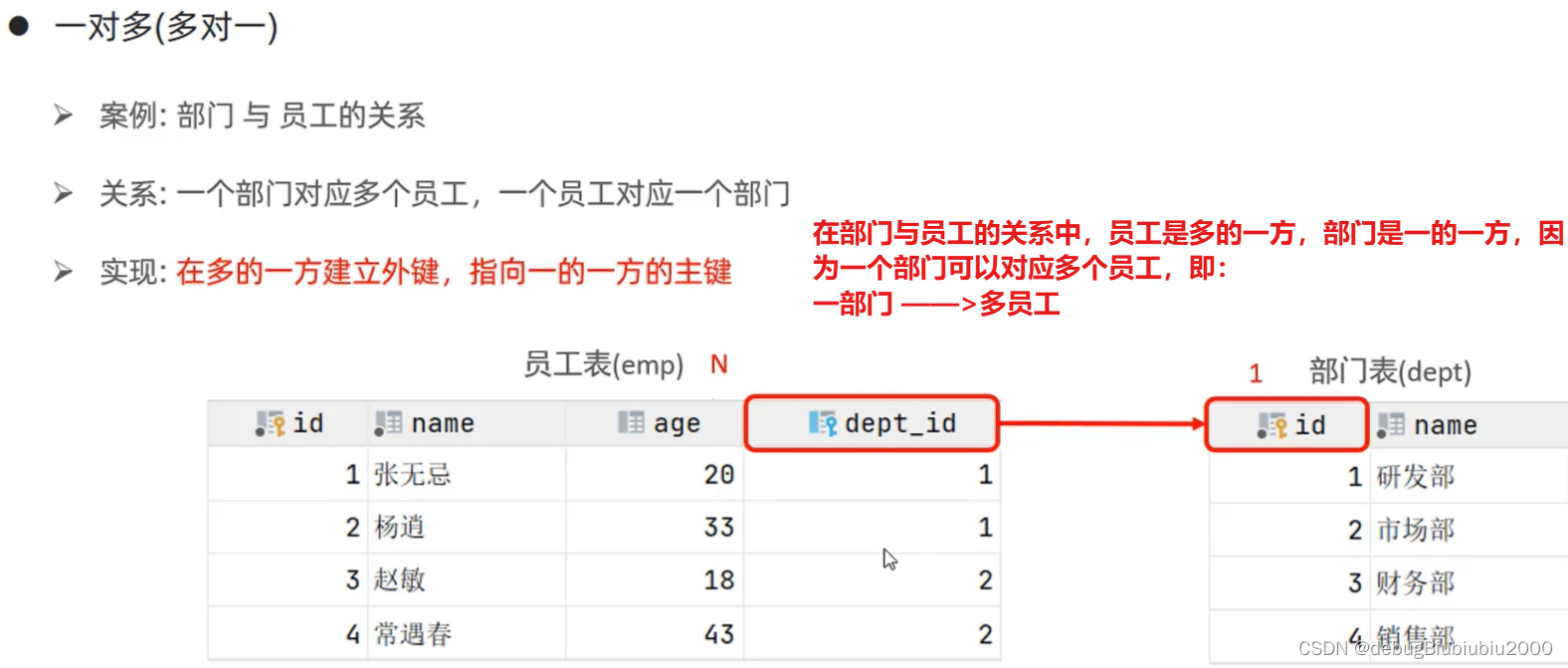
多对多
多对多是通过中间表实现的
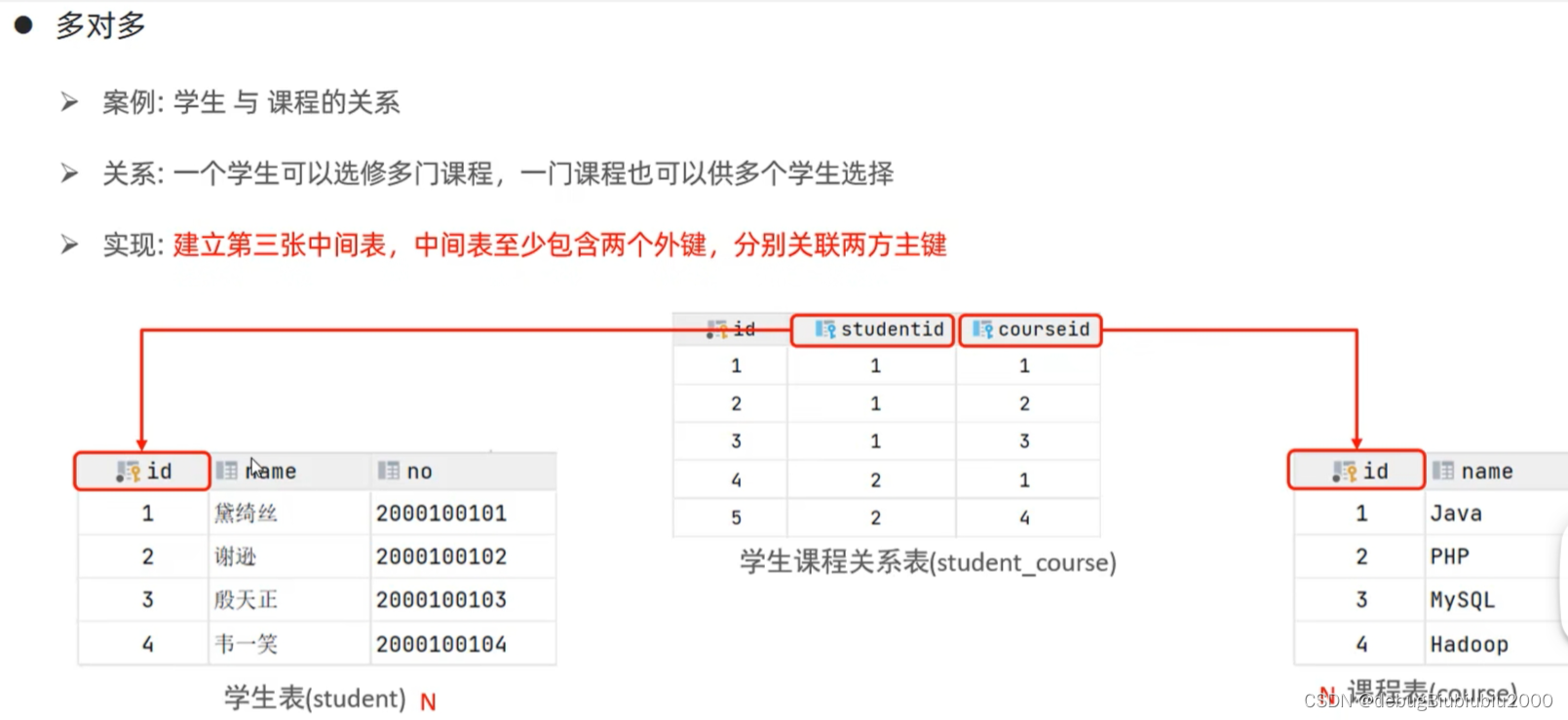
-- 创建学生表
create table student
(id int auto_increment primary key comment 'ID',name varchar(10) comment '姓名',no varchar(3) comment '学号'
) comment '学生表';insert into student
values (null, '黛绮丝', '001'),(null, '谢逊', '002'),(null, '小明', '003'),(null, '小红', '004');-- 创建课程表
create table course
(id int auto_increment primary key comment 'ID',name varchar(10) comment '课程名称'
) comment '课程表';insert into course
values (null, '语文'),(null, '数学'),(null, '英语');-- 创建中间表,维护学生表和课程表之间的关系
create table student_course
(id int auto_increment primary key comment 'ID',studentid int not null comment '学生ID',courseid int not null comment '课程ID',constraint fk_courseid foreign key (courseid) references course (id),constraint fk_studentid foreign key (studentid) references student (id)
) comment '学生课程中间表';insert into student_course
values (null, 1, 1),(null, 1, 2),(null, 1, 3),(null, 2, 2),(null, 2, 3),(null, 3, 3);一对一
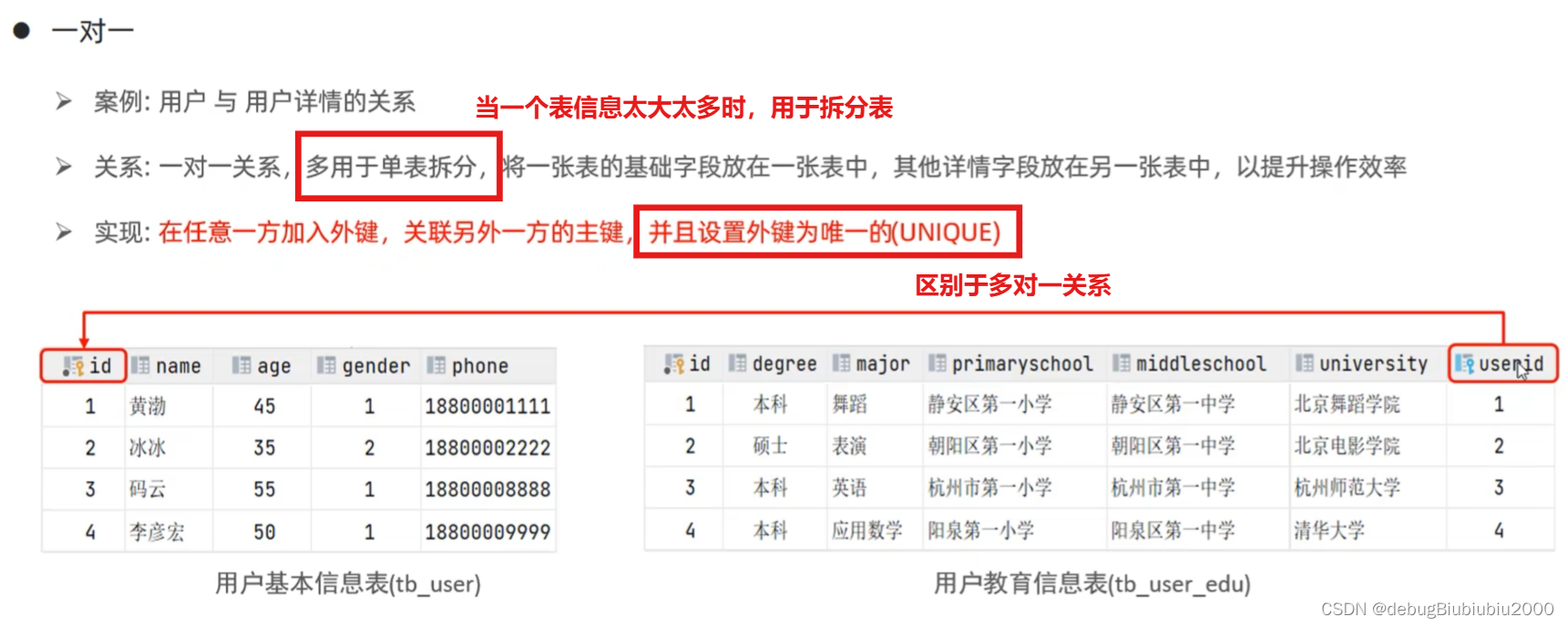
-- 创建用户表
create table tb_user
(id int auto_increment primary key comment 'ID',name varchar(10) comment '姓名',age tinyint unsigned comment '年龄',gender char(1) comment '性别',phone char(11) comment '手机号'
) comment '用户基本信息表';-- 创建用户教育信息表
create table tb_user_edu
(id int auto_increment primary key comment 'ID',degree varchar(20) comment '学历',major varchar(50) comment '专业',primaryschool varchar(50) comment '小学',middleschool varchar(50) comment '中学',university varchar(50) comment '大学',userid int unique comment '用户ID',constraint fk_userid foreign key (userid) references tb_user (id)
) comment '用户教育信息表';insert into tb_user(id, name, age, gender, phone)
values (null, '小明', 16, '1', '10000000001'),(null, '小花', 13, '2', '10000000002'),(null, '小华', 15, '1', '10000000003'),(null, '小红', 14, '2', '10000000004');insert into tb_user_edu(id, degree, major, primaryschool, middleschool, university, userid)
values (null, '本科', '舞蹈', 'XXX小学', 'XXX中学', 'XXX大学', 1),(null, '大专', '会计', 'YYY小学', 'YYY中学', 'YYY大学', 2),(null, '硕士', '英语', 'AAA小学', 'AAA中学', 'AAA大学', 3),(null, '博士', '临床医学', 'BBB小学', 'BBB中学', 'BBB大学', 4);多表查询概述
多表查询指的是从多张表中查询数据
用以下例子举例

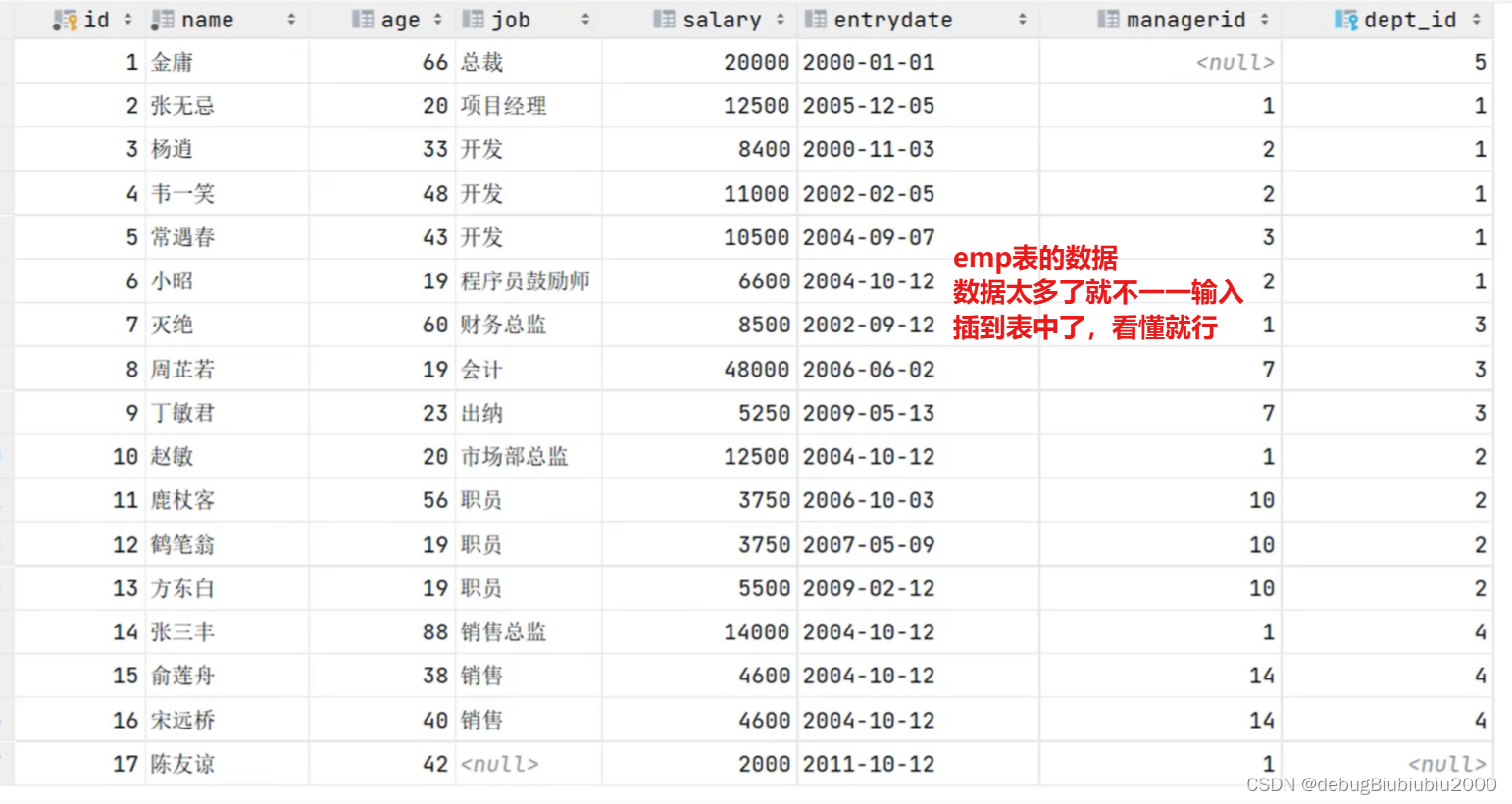
笛卡尔积
当直接查询两张表时(即执行命令:select * from emp, dept;),查询的结果就是笛卡尔积,查询结果数为两张表的数据量相乘,我们需要消除无效的笛卡尔积,如下
select *
from emp,dept
where emp.dept_id = dept.id;
多表查询分类

内连接
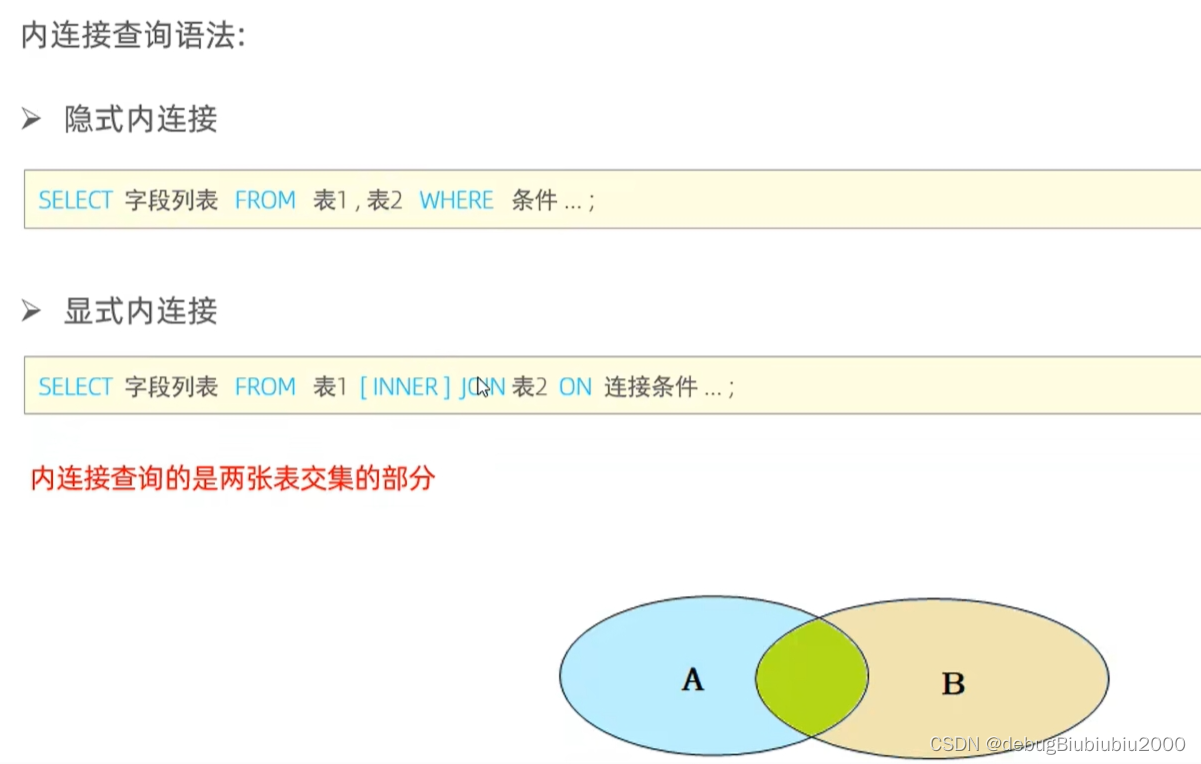
-- 隐式内连接实现:查询每一个员工姓名及其所属部门名称
select emp.name, dept.name
from emp,dept
where dept_id = dept.id;-- 显式内连接实现:查询每一个员工姓名及其所属部门名称
-- 可以给表起别名来简化代码,但是起别名之后不能再用表原来的名称
-- inner关键字可以省略
select e.name, d.name
from emp einner join dept d on e.dept_id = d.id;外连接
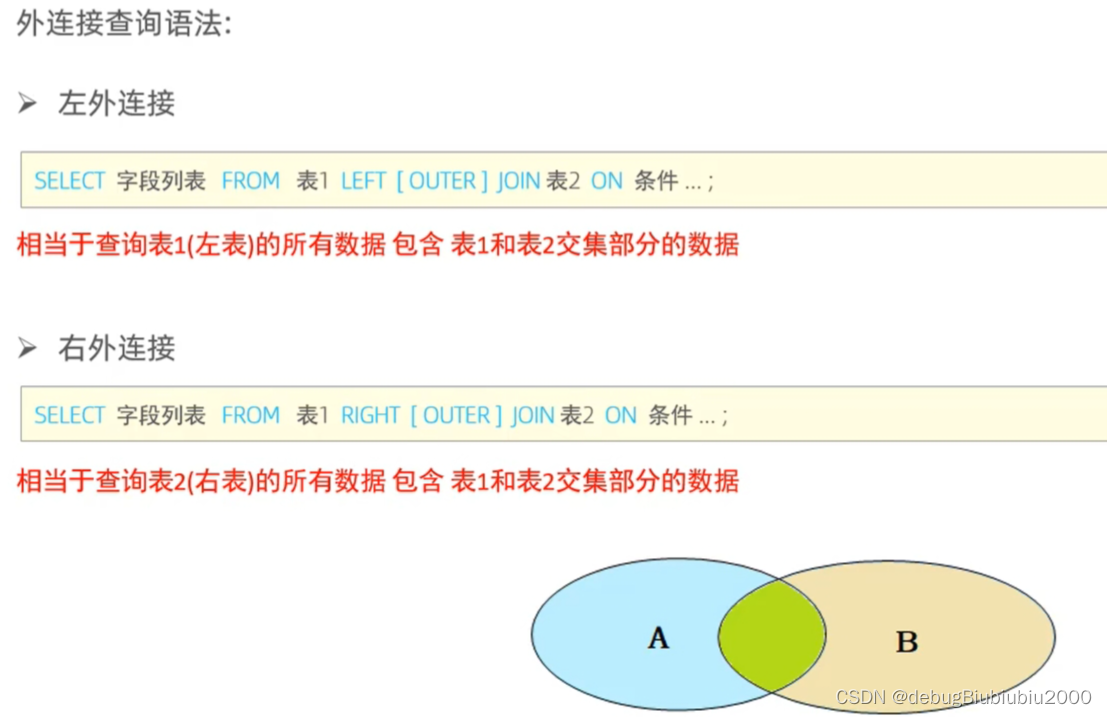
左外连接和右外连接可以相互转换,即左外连接可以用右外连接替代,右外连接也可以用左外连接替代,只需要更改关键字left、right和两个表的位置即可,这里就不展示了。
-- 查询emp表的所有数据,和对应的部门信息(左外连接)
-- outer 关键字可以省略
-- from 后跟着的表为左表,join后跟着的表为右表
-- 两个表的顺序不一样查询结果也不一样
-- 左外连接表示展示左表的所有数据,以及左表中每一条数据对应的右表数据,如果右表没有数据则显示为空
-- 右外连接则反过来,表示展示右表的所有数据,以及右表中每一条数据对应的左表数据,如果左表没有数据则显示为空
-- 自己运行一下代码就可以明白
select e.*, d.name -- e.* 表示查询emp表中的所有数据
from emp eleft outer join dept don e.dept_id = d.id;-- 查询所有的部门信息,和对应的emp表数据(右外连接(
select d.*, e.*
from emp eright outer join dept d on d.id = e.dept_id;自连接
自连接的外连接查询可以是左外也可以是右外。

-- 查询所有员工的名字及其所属领导的名字
-- 显式内连接实现
select e1.name as '员工姓名', e2.name as '领导姓名'
from emp e1join emp e2 on e1.managerid = e2.id;-- 隐式内连接实现
select e1.name '员工姓名', e2.name '领导姓名'
from emp e1,emp e2
where e1.managerid = e2.id;-- 查询所有员工的名字及其所属领导的名字,如果员工没有领导也要查询出来
-- 这里用外连接实现,用的是左外连接
select e1.name '员工姓名', e2.name '领导姓名'
from emp e1left join emp e2 on e1.managerid = e2.id;联合查询union

-- 将薪资低于5000的员工和年龄大于40的员工全部查询出来
-- 即员工满足两个条件之一就需要被查询出来
-- 有 all 关键字查询结果不去重,没有 all 则会将查询结果去重
-- 只有 select 和 from 之间的字段列表的列数和类型一致时才可以用联合查询
select *
from emp
where salary < 5000
union all
select *
from emp
where age > 40;子查询
子查询一般都用小括号括起来,可以放在 select、from、where 这几个位置(具体看后面案例)

标量子查询

-- 查询研发部的所有员工信息
select *
from emp
where dept_id = (select id from dept where dept.name = '研发部');列子查询
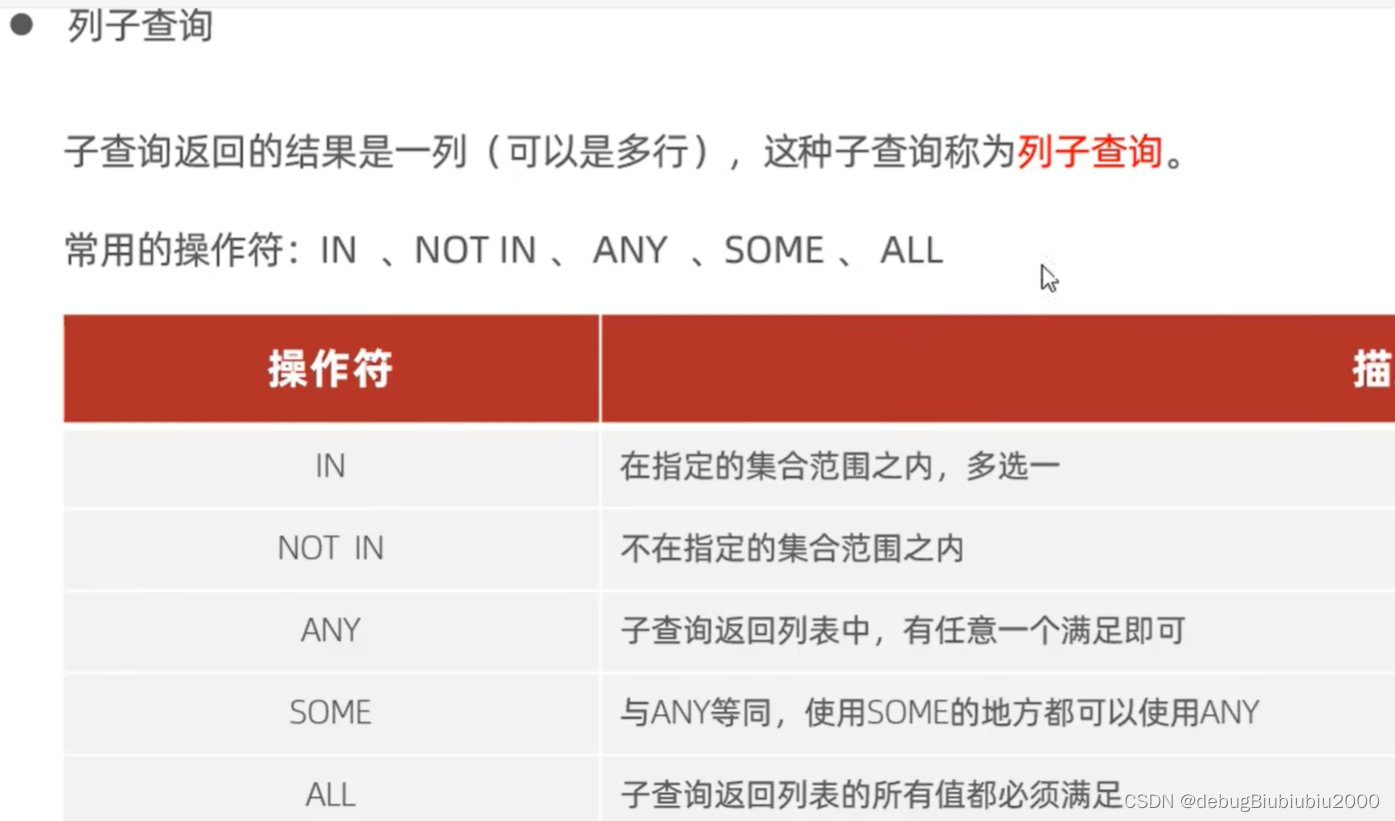
-- 查询销售部和市场部的所有员工信息
select *
from emp
where dept_id in (select dept.idfrom deptwhere dept.name in ('销售部', '市场部'));-- 查询比财务部 所有人 工资都高的员工信息
-- 查询财务部的id:select id from dept where dept.name = '财务部'
-- 先查出财务部员工最高的工资
-- select max(salary) from emp where dept_id = (select id from dept where dept.name = '研发部');
-- 实现方式1:
select *
from emp
where salary > (select max(salary)from empwhere dept_id = (select idfrom deptwhere dept.name = '财务部'));-- 实现方式2:(all)
select *
from emp
where salary > all (select salaryfrom empwhere dept_id = (select idfrom deptwhere dept.name = '财务部'));-- 查询比研发部 任意一人 工资高的员工信息(any/some)
select *
from emp
where salary > any (select salaryfrom empwhere dept_id = (select idfrom deptwhere dept.name = '研发部'));行子查询

-- 查询与“张无忌”薪资及直属领导相同的员工信息
-- 先查出张无忌的薪资和指数领导id
# select salary, managerid from emp where name='张无忌';
# 假设查出结果为(10000, 1)
# (salary, managerid) = ( select ...) => salary=10000 and managerid=1
select *
from emp
where (salary, managerid) = (select salary, managerid from emp where name = '张无忌');表子查询

-- 查询与 小明,小红 的职位和薪资相同的员工信息
# 1、查询小明,小红 的职位和薪资
select job, salary
from emp
where name in ('小明' '小红');
select *
from emp
where (job, salary) in (select job, salaryfrom empwhere name in ('小明' '小红'));-- 查询入职日期是'2018-01-01'之后的员工信息及其部门信息
# 查询入职日期是'2006-01-01'之后的员工id
select id
from emp
where entrydate > '2006-01-01';# (select * from emp where entrydate > '2006-01-01') 查询结果作为一张临时表
# 给临时表起别名为 e
select e.*, d.name
from (select * from emp where entrydate > '2006-01-01') eleft join dept d on e.dept_id = d.id;多表查询案例练习
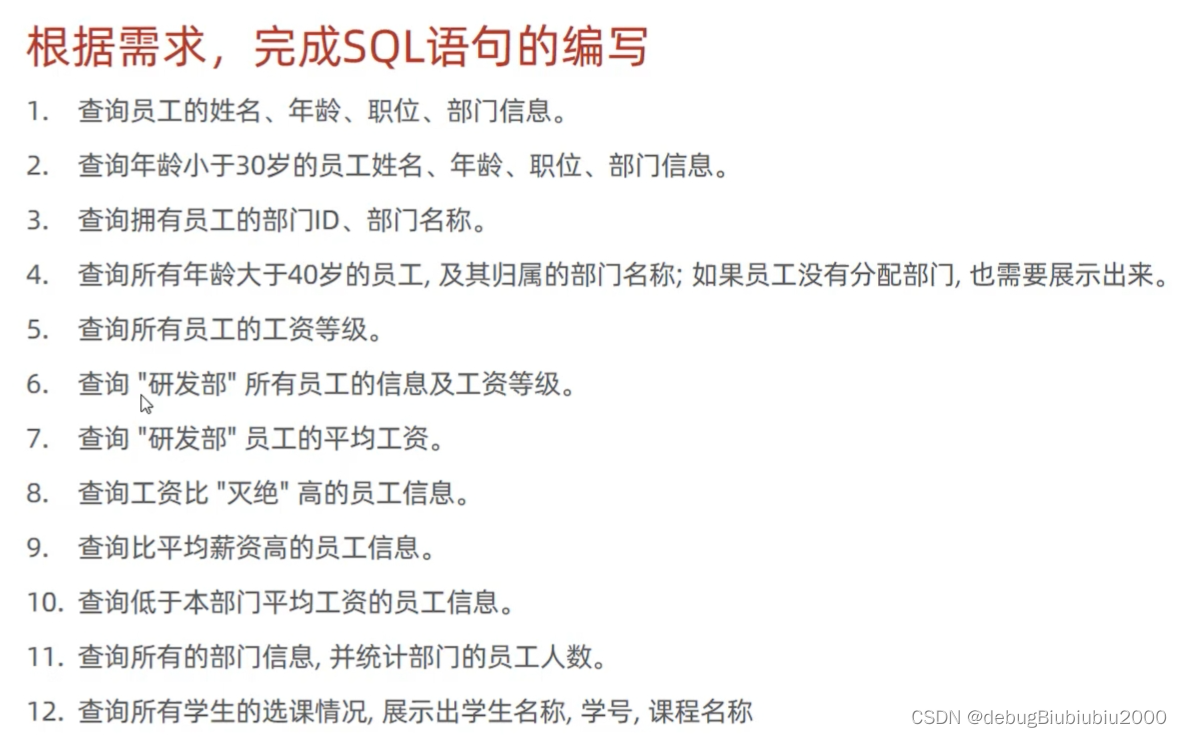
上面的例子涉及之前所说的emp员工表、dept部门表和薪资等级表,薪资等级表的表结构如下:
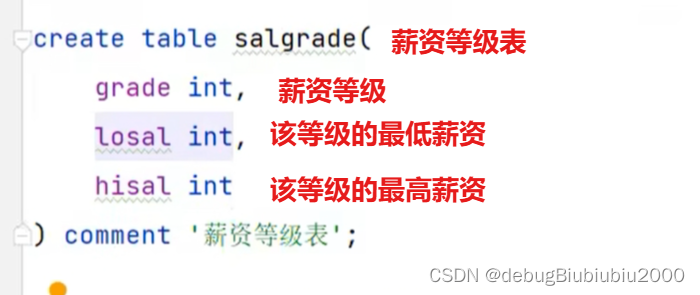
三张表的结构如下:

-- 例题1(隐式内连接)
select e.name, e.age, e.job, d.name
from emp e,dept d
where e.dept_id = d.id;-- 例题2(显式内连接)
select e.name, e.age, e.job, d.name
from emp einner join dept d on e.dept_id = d.id
where e.age < 30;-- 例题3(结果要去重)
select distinct d.id, d.name
from dept dinner join emp e on d.id = e.dept_id;-- 例题4(左外连接)
select e.*, d.name
from emp eleft outer join dept d on e.dept_id = d.id
where e.age > 40;-- 例题5
# 隐式内连接
select e.name, sg.grade
from salgrade sg,emp e
where e.salary between sg.losal and sg.hisal;# 显式内连接
select e.name, sg.grade
from salgrade sginner join emp e on e.salary between sg.losal and sg.hisal;-- 例题6
select e.*, sg.grade
from emp e,salgrade sg
where e.dept_id = (select id from dept d where d.name = '研发部')and e.salary between sg.losal and sg.hisal;-- 例题7
# 方式一
select avg(e.salary)
from emp e
where e.dept_id = (select d.id from dept d where d.name = '研发部');# 方式二
select avg(e.salary)
from emp e,dept d
where e.dept_id = d.idand d.name = '研发部';-- 例题8
select *
from emp
where salary > (select salary from emp where name = '灭绝');-- 例题9
select *
from emp
where salary > (select avg(salary) from emp);-- 例题10(放在where位置的子查询)
select e1.*
from emp e1
where e1.salary < (select avg(e2.salary)from emp e2where e1.dept_id = e2.dept_id);-- 例题11(放在select位置的子查询)
select d.id,d.name,(select count(e.id)from emp ewhere e.dept_id = d.id) '部门员工数量'
from dept d;-- 例题12
select s.name, s.no, c.name
from student_course sc,student s,course c
where sc.courseid = c.idand sc.studentid = s.id;













)



)
之字符设备)